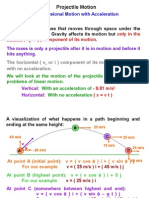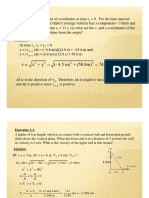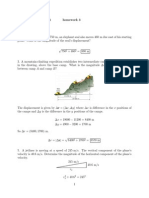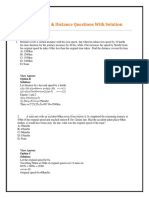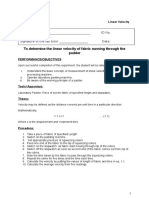Projectile Questions
Projectile Questions
Uploaded by
Nihal SinghCopyright:
Available Formats
Projectile Questions
Projectile Questions
Uploaded by
Nihal SinghOriginal Description:
Original Title
Copyright
Available Formats
Share this document
Did you find this document useful?
Is this content inappropriate?
Copyright:
Available Formats
Projectile Questions
Projectile Questions
Uploaded by
Nihal SinghCopyright:
Available Formats
Harder Examples Using The Above Methods EXAMPLE 1 : A cannonball is fired from the top of a cliff.
It has an initial velocity of 40m .s-1 at an angle of 30o to the horizontal. If the cliff height is 100m high, how long will it take t o hit the ground and what will be its horizontal displacement of the cannonball? (Assume that acceleration due to gravity is 9.8 m.s-1) SOLUTION : u = 40m.s-1 uv = 20 m.s-1 ? = 30o h = 100m g = 9.8 m.s-2 The length of time in the air will only be affected by the vertical component of u (i.e. usin, 40 sin30o = 20 m.s-1) By the time the ball reaches the same height as the cliff top on its downward trip it will be moving at its initial vertical component (i.e. 20 m.s-1) but in the opposite direction. Make UP a positive value and DOWN a negative value. The ball's final velocity can be found with v2 = u2 + 2gs v2 = (20)2 + 2 (9.8)(100) v2= 2360 v = 48.6 m.s-1 The time spent in the air can now be found by using the formula v = u + g t Remember to use the right signs when substituting in this equation -48.6 = 20 + (-9.8)t -68.6 = (-9.8)t 7 = t Time spent in air = 7 seconds. The horizontal displacement is given by the horizontal speed component uh (i.e. 40cos30 = 34.6 m.s-1) multiplied by the time the ball was in the air. s = uht s = 34.6 x 7 s = 242 metres EXAMPLE 2 : To fulfil a lifelong dream, Tang is shot from a cannon at 100 m.s-1 and at 80o t o the hard concrete surface. How high will Tang go before he starts to fall back down to th e ground? SOLUTION : u = 100m.s-1 g = 9.8 m.s-2 ? = 80o
The horizontal component of Tang can be neglected in this question. Only the ver tical component (uv = 100sin80o = 98.5m.s-1) is important. At the top of his flight Tang will have a final velocity of 0 m.s-1 Make UP positive values and DOWN negative values. Using the formula v2 = u2 + 2gs 0 = (100)2 + 2 (- 9.8) s s = -10000/-19.8 s = 505 metres Tang will rise 505 metres into the air before he starts to fall back down. EXAMPLE 3 : A banana is thrown by a gorilla from the ground at 36km/h at an angle of 30 degr ees to the ground: a) b) c) d) What is What is How far How old the time of flight of the object? the object s maximum height? away does the object land from the gorilla? is the gorilla?
SOLUTION : Data : x = 30 degrees. u = 36 km/h = 36000m/3600s =10m/s
Method 1: This method involves re-deriving the boxed formulas which were created above, and is necessary when doing more difficult questions. uh = ucosx = 10 x cos 30 = 10 x 0.866 = 8.66m/s uv = usinx = 10 x sin 30 = 10 x 0.5 = 5m/s a) v = uv + at 0 = 5 - 9.8 x t t = 5/9.8 t = 0.5102 Total time = 2 x t = 1.02m/s b) v2 = uv2 + 2as 0 = 52 - 2 x 9.8 x s s = 25/(2 x 9.8) s = 1.28m c) Range = time of flight x ucosx Range = 1.02.x 8.66 Range = 8.83m Method 2 : This is method will directly use the formulas above, and is quite ok when doing more simple questions. a) t = usinx/4.9 t = 10sin 30 / 4.9 t = 1.02m/s b) s = (usinx)2/19.6 s = (10sin30)2 /19.6
s = 1.28m c) range = utcosx range = 10 x 1.02 x cos30 range = 8.83m EXAMPLE 4 : A person throws a tomato off the harbour bridge at 30m/s and at an angle of 30 degrees to the bridge. The harbour bridge happens to be 30m above the water (how convenient). a) b) c) d) What What What What is is is is the the the the total time of flight? maximum height of the tomato from the water? range of the tomato? velocity of the tomato just before it hits the water.
SOLUTION : With these more difficult questions it is easier to derive everything. Data : u = 30m/s x = 30 degrees height of bridge = 30m/s uv = usinx = 30sin30 = 15m/s uh = ucosx = 30cos30 = 25.99m/s a) Let us consider the question in two parts, that is above and below the level of the bridge. v = uv + at 0 = 15 - 9.8t t = 15/9.89 t = 1.53m/s Total time above the bridge = 3.06m/s Now when the tomato reaches the level of the bridge again, it s velocity downwards is the same as the velocity it was launched at. (note gravity is now positive a s it is heading in the same direction as the tomato). s = uvt + 0.5at2 30 = 15 x t + 0.5 x 9.8 x t2 4.9t2 + 15t - 30 = 0 Using the quadratic equation, t = 1.38 or -43.5 But since there is no such thing is negative time, the answer is 1.38s Hence total time of flight = 3.06 + 1.38 = 4.44m/s b) v2 = uv2 + 2as 0 = 152 - 2 x 9.8 x s s = 225/(2 x 9.8) s = 11.48m (above the bridge) Thus, maximum height above water = 11.48 + 30 = 41.48m c) Range = total time of flight x uh Range = 4.44 x 25.99
Range = 115.40m d) Again, this involves working with values when the tomato reaches the level of the bridge, vertical velocity = 15 + 9.8 x 1.38 (t=1.38 is the time required for the object to reach the ground from the level o f the bridge) vertical velocity = 28.524m/s horizontal velocity = 25.99m/s Using pythagoras s theorem, u2 = uh2 + uv2 (where u is the resultant velocity) u2 = 28.5242 + 25.992 u = 38.59m/s Thus the velocity is 38.59m/s just before it hits the water. EXAMPLE 5 : A launcher at ground level can fire boomerangs at 60m/s. If Chester is 300metres away, at what angle must the boomerang be fired to hit Chester? SOLUTION : uv = 60sinx t = uv/4.9 (using the formula for total time of travel) t = 60sinx/4.9 total time of travel = 12.25sinx Now, Range = uh x total time of travel 300 = 60cosx x 12.25sinx 735sinxcosx = 300 2sinxcosx = 0.816 sin2x = 0.816 (note one of the trigonometric identities you may not have learnt is sin2x = 2si nxcosx) 2x = 54.72 or 125.28 degrees x = 27.36 or 62.64 degrees Hence the cannon must be fired at either 27.36 or 62.64 degrees to hit Chester. Now that you ve seen some of the mathematics behind Projectile Motions, you can pl ay our own specially designed projectile motion game, starring Chester himself. Specifying your velocity and angle of projection, you can attempt to hit Chester using a variety of objects. COOL eh?
You might also like
- HW02 SolutionsDocument5 pagesHW02 Solutionshansony_2100% (3)
- 4th Quarter - Grade 9 Uniformly Accelerated MotionDocument47 pages4th Quarter - Grade 9 Uniformly Accelerated Motionvengie arellano93% (15)
- Projectile Motion Guide For AP Physics 1Document27 pagesProjectile Motion Guide For AP Physics 1renenutet100% (2)
- Jacaranda Physics Worked SolutionsDocument7 pagesJacaranda Physics Worked SolutionsaNo ratings yet
- Examples Solutions Answers Section1 01Document5 pagesExamples Solutions Answers Section1 01biligalaNo ratings yet
- P6 TonetDocument12 pagesP6 TonetAlyssa Fermin0% (1)
- Manik - ME 072052 Ruet: Chapter 11, Solution 1Document211 pagesManik - ME 072052 Ruet: Chapter 11, Solution 1Selino CruzNo ratings yet
- KinematicsDocument7 pagesKinematicsNicole WheelerNo ratings yet
- Physics SS2 Week 4 MyDocument12 pagesPhysics SS2 Week 4 Myjczaza3No ratings yet
- Motion Under GravityDocument5 pagesMotion Under GravityRizul thakur100% (2)
- Distance and DisplacementDocument37 pagesDistance and DisplacementHany ElGezawyNo ratings yet
- Solve ThisDocument2 pagesSolve Thisvarshankuppaswamy777123No ratings yet
- Phys101 - A6 - Lim - Module 1 - AssignmentDocument16 pagesPhys101 - A6 - Lim - Module 1 - AssignmentJocel Erick P. LimNo ratings yet
- Portfolio PhysicsLecDocument44 pagesPortfolio PhysicsLecJohn Eazer FranciscoNo ratings yet
- Dynamics of Rigid Bodies 2 1Document17 pagesDynamics of Rigid Bodies 2 1vladz grabadorNo ratings yet
- More Solved ProblemsDocument4 pagesMore Solved ProblemsSyed AfrozNo ratings yet
- Dynamics Sample ProblemsDocument17 pagesDynamics Sample ProblemsLou Berwel Domingo71% (7)
- The Speed of A Projectile When It Is at Its Greatest Height IsDocument2 pagesThe Speed of A Projectile When It Is at Its Greatest Height IsNandan AnnamrajuNo ratings yet
- PhyI Assign&Answers 2011Document16 pagesPhyI Assign&Answers 2011Austin Phua Yun Hock100% (1)
- Projectiles SolutionsDocument9 pagesProjectiles SolutionsNickolas RogersNo ratings yet
- FREE FALL AND PROJECTILEdsadDocument7 pagesFREE FALL AND PROJECTILEdsadDave BillonaNo ratings yet
- Mechanics Motion Under Gravity and ProjectilesDocument11 pagesMechanics Motion Under Gravity and ProjectileschidubemofNo ratings yet
- Physics Kinematics in Two DimensionsDocument26 pagesPhysics Kinematics in Two DimensionsMeklitNo ratings yet
- KinematicsDocument65 pagesKinematicsGarlapati Srinivasa Rao100% (1)
- Chapter2Kinematics With Constant Accelerationin1dDocument12 pagesChapter2Kinematics With Constant Accelerationin1dnsbaruaoleNo ratings yet
- Calculus Word Problems IDocument20 pagesCalculus Word Problems IPatricia SioNo ratings yet
- File - 1707794011 - Gravitation NumericalsDocument8 pagesFile - 1707794011 - Gravitation NumericalsMaghil shreeNo ratings yet
- Lecture 1aDocument22 pagesLecture 1aJingjing ChanNo ratings yet
- 10 Solved Prob Part 2Document9 pages10 Solved Prob Part 2Ryan ReyesNo ratings yet
- Ch12 Kinematics - of - A - ParticleDocument46 pagesCh12 Kinematics - of - A - ParticletarntodNo ratings yet
- Lesson 1: Rectilinear Translation MotionDocument39 pagesLesson 1: Rectilinear Translation MotionAaron EserNo ratings yet
- ExamDocument136 pagesExamMichael Vincent MirafuentesNo ratings yet
- Projectile MotionDocument35 pagesProjectile MotionNiel A.No ratings yet
- Dyna ProjectDocument58 pagesDyna ProjectCarlo Domanais0% (3)
- Extra QuestionsDocument7 pagesExtra QuestionshelloNo ratings yet
- Solve Dynamic Problem 3Document4 pagesSolve Dynamic Problem 3usama naeemNo ratings yet
- CH - 3 Motion in A Straight LineDocument41 pagesCH - 3 Motion in A Straight LineishayanarahtNo ratings yet
- Physics Book 3-1Document61 pagesPhysics Book 3-1ScienceGuy HiltonNo ratings yet
- 3-1Document9 pages3-1ironmananish7No ratings yet
- MotioninAStraightLine Paper 01Document9 pagesMotioninAStraightLine Paper 01intelligentc47No ratings yet
- CH 2Document4 pagesCH 2Civil NutNo ratings yet
- (25407) 16. H Equations of Motion AnswersDocument3 pages(25407) 16. H Equations of Motion Answersmaduhu.botswanaNo ratings yet
- ISV SM Ch02Document6 pagesISV SM Ch02space5561No ratings yet
- Physics - Rigid Body Dynamics SolutionsDocument2 pagesPhysics - Rigid Body Dynamics SolutionsPranavMachingal0% (1)
- Problem - 3A PDFDocument14 pagesProblem - 3A PDFMonicaNo ratings yet
- Electric Field Practice ProblemsDocument13 pagesElectric Field Practice ProblemsJaymar F. NabungNo ratings yet
- Equations of Rectilinear MotionDocument12 pagesEquations of Rectilinear MotionHubert AgamasuNo ratings yet
- Projectile MotionDocument8 pagesProjectile MotionremotodepaduajerezNo ratings yet
- A Net Force of 15 N Is Exerted On An Encyclopedia To Cause It To Accelerate at A Rate of 5 MDocument5 pagesA Net Force of 15 N Is Exerted On An Encyclopedia To Cause It To Accelerate at A Rate of 5 MAngie CondezaNo ratings yet
- Examples PDFDocument1 pageExamples PDFjhane neilleNo ratings yet
- Physics Help Problems W SolutionsDocument11 pagesPhysics Help Problems W SolutionsbuffmomNo ratings yet
- Physics ProblemsDocument8 pagesPhysics ProblemshaniiramosNo ratings yet
- Experiment Paper - ProjectileDocument4 pagesExperiment Paper - ProjectileelleiabNo ratings yet
- Unit 1.1 - Mechanics - Kinematics (Student)Document12 pagesUnit 1.1 - Mechanics - Kinematics (Student)Quay Wei KwangNo ratings yet
- PHYS 111 Homework #5: Due: 29 Sept. 2016Document9 pagesPHYS 111 Homework #5: Due: 29 Sept. 2016ShinaNo ratings yet
- VideoLesson GenPhysics Q1 M3 L3Document9 pagesVideoLesson GenPhysics Q1 M3 L3おい ビッチNo ratings yet
- Freefall WS-MSDocument6 pagesFreefall WS-MSfarahfalsakhenNo ratings yet
- Solutions of Kinematics HC Verma Chapter 3Document16 pagesSolutions of Kinematics HC Verma Chapter 3Wave Education100% (1)
- O level Physics Questions And Answer Practice Papers 2From EverandO level Physics Questions And Answer Practice Papers 2Rating: 5 out of 5 stars5/5 (1)
- Transistor As An AmplifierDocument2 pagesTransistor As An AmplifierNihal SinghNo ratings yet
- After Twenty Years + The Gold Watch+ The Selfish Giant.Document3 pagesAfter Twenty Years + The Gold Watch+ The Selfish Giant.Nihal SinghNo ratings yet
- My Struggle For An EducationDocument7 pagesMy Struggle For An EducationNihal Singh0% (2)
- Coolidge Tube DescriptionDocument7 pagesCoolidge Tube DescriptionNihal SinghNo ratings yet
- Long Answers of Light of AsiaDocument7 pagesLong Answers of Light of AsiaNihal Singh0% (1)
- Gravitation NUMERICALSDocument25 pagesGravitation NUMERICALSNihal SinghNo ratings yet
- Problems 12 - DifferentiationDocument11 pagesProblems 12 - DifferentiationNihal SinghNo ratings yet
- TrojanDocument1 pageTrojanNihal SinghNo ratings yet
- Your SuccessDocument1 pageYour SuccessNihal SinghNo ratings yet
- Circular MotionDocument2 pagesCircular MotionNihal SinghNo ratings yet
- Reshuffling Practice PapersDocument86 pagesReshuffling Practice PapersKing of AwesomeNo ratings yet
- ME-313 Mechanics of Machines Velocity Analysis - Part A: by Adnan MunirDocument20 pagesME-313 Mechanics of Machines Velocity Analysis - Part A: by Adnan MunirHafsa RahmeenNo ratings yet
- HESTENES Toward A Modeling Theory of Physics InstructionDocument29 pagesHESTENES Toward A Modeling Theory of Physics InstructionPablo AlbinoNo ratings yet
- 12 8Document18 pages12 8rainah ismailNo ratings yet
- Conceptual Physics Study GuideDocument6 pagesConceptual Physics Study GuideStudentHelpWW100% (1)
- Joiles Geography S.B.a.Document15 pagesJoiles Geography S.B.a.Sarah YettiNo ratings yet
- Session 1 - Speed-Time GraphDocument7 pagesSession 1 - Speed-Time GraphSelvenNo ratings yet
- CBSE 9, Physics, CBSE - Motion, Sample QuestionsDocument1 pageCBSE 9, Physics, CBSE - Motion, Sample QuestionsParth GoyalNo ratings yet
- Solution: A B A BDocument3 pagesSolution: A B A BMOHD FIRDAUS BIN JAAFAR / UPMNo ratings yet
- Icts 1Document10 pagesIcts 1Devansh Duhan100% (1)
- Chap3 Part 2Document20 pagesChap3 Part 2Jing Kai LumNo ratings yet
- Module 4 Kinetics of A Particle-Impulse and MomentumDocument72 pagesModule 4 Kinetics of A Particle-Impulse and MomentumHuy VũNo ratings yet
- Nafyad N 2 High School Physics Midd Exam For Grade 10Document2 pagesNafyad N 2 High School Physics Midd Exam For Grade 10Kebede TeseNo ratings yet
- Force Analysis On A Cyclist Riding DownhillDocument6 pagesForce Analysis On A Cyclist Riding Downhillapi-442477702No ratings yet
- Class 10 Science Chapter 8 PresentationDocument68 pagesClass 10 Science Chapter 8 PresentationTeena AroraNo ratings yet
- Lab 2 Measurement and Modeling MotionDocument5 pagesLab 2 Measurement and Modeling Motionjsm1012No ratings yet
- 4 1000+ Speed Time and Distance Question PDF (Questions & Solution)Document37 pages4 1000+ Speed Time and Distance Question PDF (Questions & Solution)Santa Kal100% (1)
- SHS-General Physics 1Document25 pagesSHS-General Physics 1JC PerezNo ratings yet
- Pump Head CalculationsDocument65 pagesPump Head CalculationsAnonymous TjdHCu100% (1)
- ملزمة خامس علميDocument40 pagesملزمة خامس علميBetool AlghalbiNo ratings yet
- Mellinger ICRA2011Document6 pagesMellinger ICRA2011kevin3ventocilla123No ratings yet
- Chute Performance and Design For Rapid Flow ConditionsDocument8 pagesChute Performance and Design For Rapid Flow Conditionsscrane@No ratings yet
- Physics Set A AKDocument3 pagesPhysics Set A AKCherry Grace Articulo Dabucon100% (1)
- Chapter 09Document59 pagesChapter 09h44n00No ratings yet
- Clrjj6jvw3ms1nox40o6dk10p How These Activities Support The Ngss Science Standards CP Part 1Document3 pagesClrjj6jvw3ms1nox40o6dk10p How These Activities Support The Ngss Science Standards CP Part 1shantanu.deo.photos1No ratings yet
- Question PaperDocument24 pagesQuestion Papernoman21No ratings yet
- BB101Document127 pagesBB101Fly WithmeNo ratings yet
- L01 Average SpeedDocument9 pagesL01 Average SpeedJohn JohnsonNo ratings yet
- Complete Textile Mechanics LabDocument47 pagesComplete Textile Mechanics LabEngr Mujahid MehdiNo ratings yet


